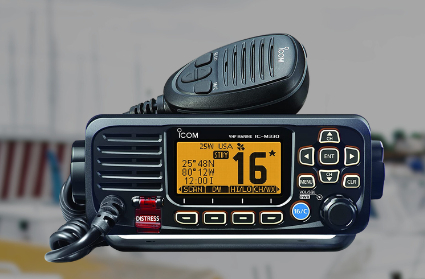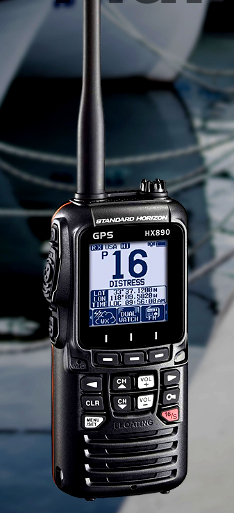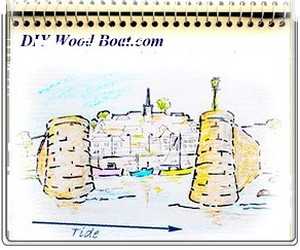Digital Selective Calling VHF, An Easy Guide for Leisure Boaters
|
To increase the effectiveness of the VHF radio, Digital Selective Calling (DSC) technology has been introduced. DSC enhances the standard VHF radio by adding an extra level of safety and convenience, allowing you to call specific vessels or groups directly, without needing to hold a channel open or monitor it continuously. DSC uses digital data rather than voice alone, allowing you to send predefined messages. This makes communication faster, more efficient and often more reliable, especially when under distress. |
The Importance of DSC VHF

Having a DSC-capable VHF radio on your boat enables you to send an automatic distress signal at the press of a button should an emergency situation arise.
Digital Selective Calling (DSC) is primarily used to initiate distress calls to shore stations and other vessels via your DSC radio and provides recipients of your emergency call with:
Your Vessel’s Identity
Your Precise Position (if interfaced with GPS)
Your Unique MMSI Number (Maritime Mobile Service Identity)
The Nature of your Distress
All DSC-equipped shore stations and vessels will hear your distress signal as an alarm.
It will be repeated every 4 minutes until acknowledged.
A DSC alert signal has a 15% greater range than a voice transmission and therefore is more likely to reach a vessel or rescue centre.
In a potentially dangerous situation, a DSC alert signal is the quickest way to initiate emergency communications with ships and rescue coordination centres.
DSC saves vital time by allowing you to speak to the emergency authorities and plan your next move.
If integrated with GPS navigational equipment (highly recommended), a vessel’s position and time of transmission are automatically included in the DSC distress and urgency alerts.
Your EPIRB can’t do that.
Your satellite phone can’t do that.
AIS can’t do that.
Additionally, DSC VHF radios bring user-friendly features, such as direct calling and position tracking, making your sea adventures safer and communication easier.
How To Use Digital Selective Calling
Operating a DSC VHF radio might sound complex, but trust us, it's a lot simpler in practice than it sounds.
To set up and use a DSC-capable radio, you would need a Maritime Mobile Service Identity (MMSI) number, which is essentially your unique identifier on the oceanic communication network.
You can obtain this nine-digit MMSI number by registering your boat with the FCC or a recognized organization.
Once you have this number, it needs to be programmed into your DSC-equipped radio.
Most DSC-capable VHF radios have an easy-to-use interface.
For the distress signal, there's usually a red button labelled 'Distress' on the DSC VHF radio.
If you press and hold it for a few seconds, it automatically sends an alert with your MMSI number and GPS position to all DSC-equipped devices within range.
Remember that initiating a distress call using DSC should only be done in case of a genuine emergency.
Misuse of this important feature can potentially divert resources from real emergencies.
For calling other vessels whose MMSI number you know, for instance when sailing in company, you simply select the specific vessel you want to call, dial in their MMSI number, and your call is put through to that boat only.
Handheld DSC-VHF radios

Handheld DSC radios have their own, unique MMSI number format.
Because handheld DSC’s can be carried from ship to ship, they must not be programmed with a ship’s MMSI.
Anyone who already holds a Ship Portable Radio Licence can go onto the OFCOM website and simply add VHF DSC handheld to their list of equipment.
Maintaining Your DSC VHF Radio
Maintenance of your VHF radio is as important as learning how to use it.
Regular inspections should be done to ensure that the equipment is functioning properly.
This includes checking the battery charge, verifying the function of buttons and knobs, and testing routine functions, such as the transmission and reception of signals.
Continuous Learning
Like all essential equipment on smaller boats, continuous learning and familiarisation with the operation of your DSC VHF radio is highly encouraged.
Going beyond understanding the basics, familiarise yourself with advanced features like paging, position polling and tracking.
While it may take some time initially, navigating these features will eventually become second nature.
Selling your boat
When selling your boat, it’s wise to include any hand-held DSC-VHFs in the purchase and not take them with you to the new vessel.
It would be dangerous to have the same MMSI being used by more than one vessel, and hand-held DSC-VHF radios often need to be sent to the manufacturer for a “factory reset” before they can be updated with a new MMSI number – a time-consuming process.
Unlike a phone number that stays with you when you move across town, a boat’s MMSI always stays with the boat, so any subsequent owner must update the MMSI number with his or her new contact information.
To make this easier, print a copy of your MMSI certificate, write down your registration login name and password and keep it in a safe place.
This will make managing your boat’s MMSI easier if any registration details change or when it is sold to a new owner.
Conclusion
In conclusion, the Digital Selective Calling VHF radio is an all-important communication tool for leisure boaters.
It offers a host of benefits, and with a bit of practice, it's a straightforward and intuitive navigation and safety equipment.
So, seize this technology today for a safer and more comfortable experience at sea! Happy cruising!














